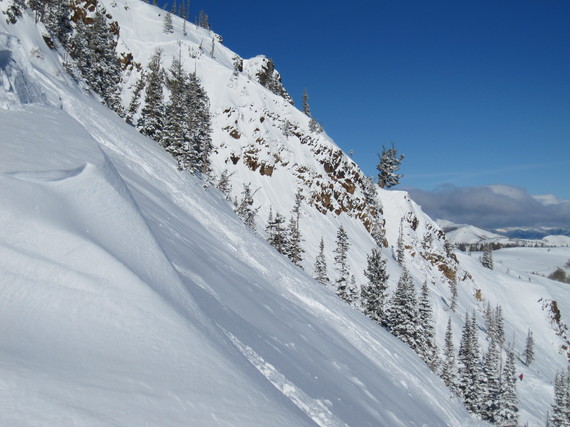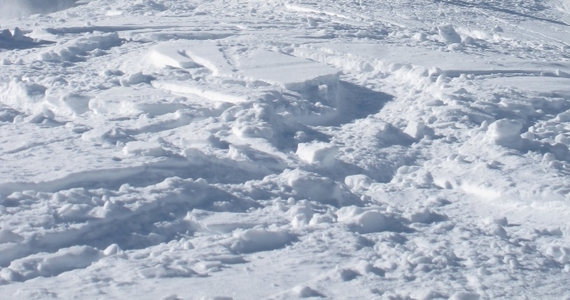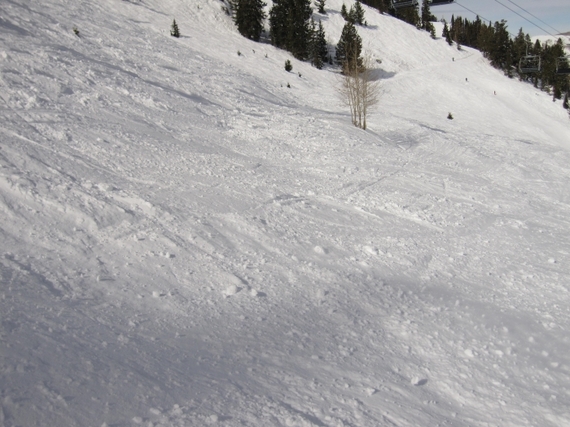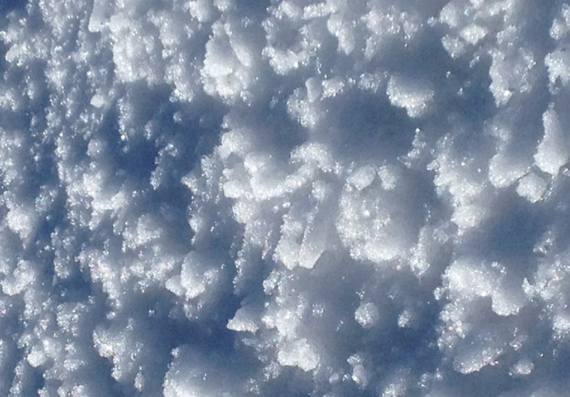For skiers above a basic level of proficiency, snow conditions can affect a slope's difficulty more than the steepness. A steep chute with 6 inches of fresh powder may be less daunting than an intermediate trail with hard-packed snow.
Given the importance of snow conditions, skiers and boarders love to discuss crystallized water in all its forms and variations. Here's a glossary (somewhat in order of desirability depending on preferences).
Powder
Fresh snow is held up as the Holy Grail for ski conditions. Especially when the fresh totals go above 6 inches or so, powder is not necessarily the easiest to ski for those who have never experienced such deep snow. Even with today's wider skis, deep powder requires some technique adjustment, because turns happen inside a 3-D environment of snow, rather than completely on top of a surface. Learning the right technique is well worth the effort to experience the floating feeling of powder skiing.
Hero Snow
This term is based more on subjective opinion, rather than specific physical characteristics of the snow. Hero snow is simply easy to ski, so you can "look like a hero" even with flaws in technique. For most skiers, this translates into forgiving soft snow that's not too deep with a solid base underneath for making turns.
Corduroy
When resorts groom trails overnight, the snowcats leave behind a pattern of small ridges in the snow that are reminiscent of corduroy fabric. Fresh corduroy is generally smooth and predictable, so it is a favorite of skiers who like to ski fast or "rip corduroy."
Crud
The name sounds nastier than the reality. The definition of crud can vary, but often it just means powder that has been tracked out to an extent. Crud can be fun to ski, but in a sense it's the opposite of corduroy in that it's unpredictable. Skiers must keep their balance going back and forth between deep and packed snow.
Packed Powder
When it hasn't snowed for at least a couple of days, this seems to be the default snow condition for resorts' morning reports. Packed powder simply means skiers and boarders have packed down the snow, but it's still fairly soft and skiable.
Corn
This elusive snow is actually very desirable and often falls in the "hero snow" category, but it can be hard to time. It is generally found in the spring when freeze/melt cycles affect the snow. Large grains of snow freeze together overnight, then they loosen as the sun warms them during the day. Corn refers to the snow during the time window when it has become soft and forgiving, but not too wet and slushy. In other words, it's the "Goldilocks" of snow--not too hard, not too soft, but just right.
Firm Conditions
Again often found in the spring, snow that has refrozen overnight has an icy glaze on it that makes it tough to edge into with skis. The morning skiing can feel like skittering across a coral reef. In the worst cases, clumps of refrozen snow form "frozen chicken heads." In this situation, head for the corduroy until the corn arrives later in the day.




